Alfeñiques are delicate sugar figures that hold a special place in Día de Muertos celebrations, particularly in San Miguel de Allende. These colorful creations, shaped into skulls, animals, and other symbolic forms, are crafted to honor loved ones and adorn altars during this vibrant festival. Rooted in centuries-old traditions, alfeñiques blend Arabic, Spanish, and Mexican influences, evolving into a unique art form. In San Miguel de Allende, the annual Alfeñique Fair showcases this artistry, offering a chance to witness skilled artisans at work and celebrate the cultural richness of Día de Muertos. Discover how these sweet creations connect life, death, and heritage in a truly meaningful way.
What Are Alfeñiques?
Your journey into the world of alfeñiques begins with understanding their essence. Alfeñiques are delicate, handmade sugar paste figures, often shaped into skulls, animals, and other symbolic forms tied to Día de Muertos. These sugary creations are crafted to celebrate life and honor the deceased, adding vibrant colors and intricate details to ofrendas, or altars, across Mexico. Their presence brings joy and reverence, making them a cherished part of this deeply meaningful tradition.
Definition and Symbolism
Clearly, alfeñiques are more than just sweet treats. They are symbolic representations of life, death, and the connection between the two. Crafted with care, these sugar figures embody the sweetness of existence and the memories of loved ones who have passed. Their vibrant colors and intricate designs reflect the celebration of life, while their placement on altars serves as a heartfelt tribute to those no longer with us.
Traditional Shapes and Colors
You will find alfeñiques in a variety of traditional shapes, such as skulls, crosses, animals, and flowers. These forms are deeply symbolic, with skulls representing the cycle of life and death, and animals often symbolizing spiritual guides. The colors used are equally meaningful, with bright hues like red, yellow, and blue symbolizing vitality, while white represents purity and remembrance.
To explore deeper, the shapes and colors of alfeñiques are not random but carry profound cultural significance. Skulls, or calaveras, are the most iconic, often personalized with names or designs to honor specific individuals. Animals like dogs and deer are believed to guide spirits, while flowers symbolize the fleeting beauty of life. The use of vibrant colors ensures these figures stand out on altars, creating a joyful and celebratory atmosphere during Día de Muertos.
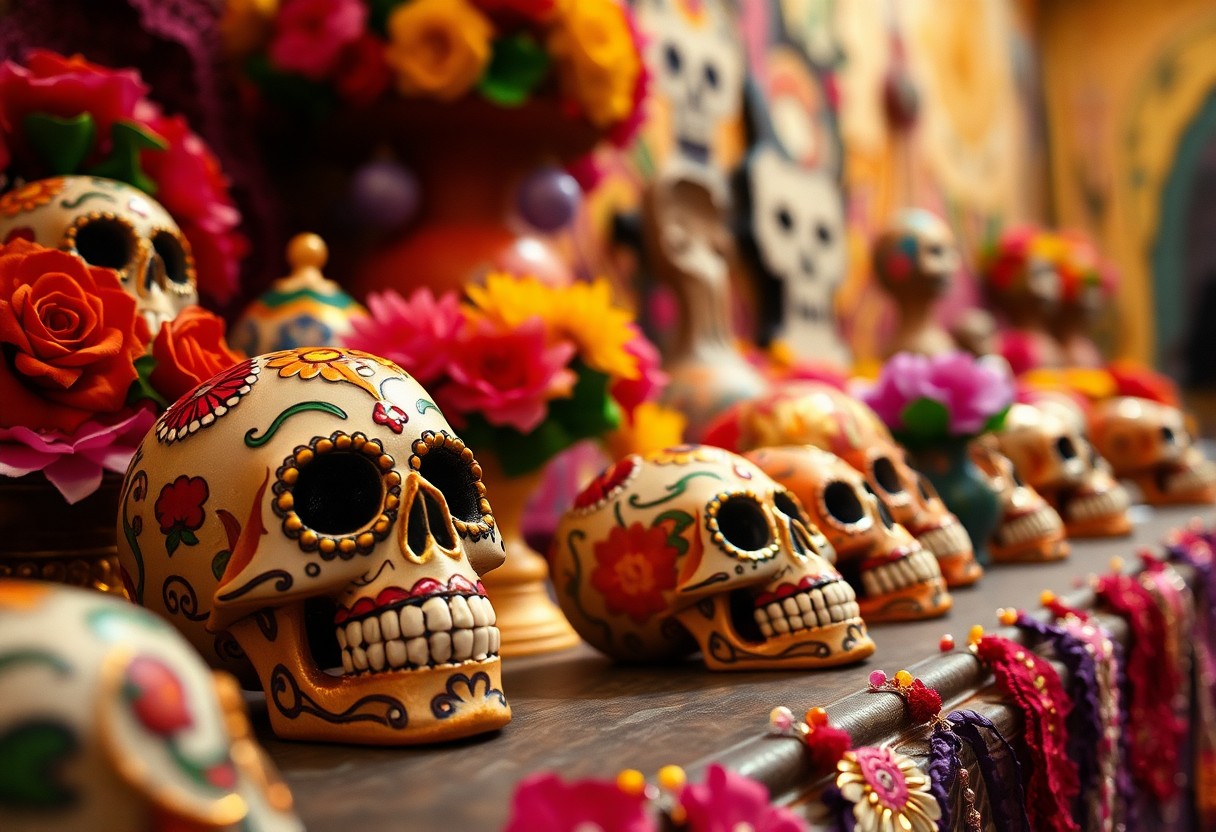
Origins and History of Alfeñiques
While the word alfeñique traces its roots to the Arabic alfainid, this sweet art form was introduced to Spain during the Moorish period and later brought to the Americas by Spanish colonizers. Originally made with almonds, sugar, and egg whites, alfeñiques evolved in Mexico to incorporate local ingredients and traditions. Over centuries, artisans refined the sugar paste recipe, creating the vibrant, whimsical figures we associate with Día de Muertos today. These sugar creations reflect Mexico’s rich cultural heritage and its ability to adapt foreign influences into something uniquely its own.
Arabic and Spanish Influences
One of the most fascinating aspects of alfeñiques is their blend of Arabic and Spanish influences. The technique of crafting sugar paste was introduced to Spain by the Moors, who used almonds and sugar to create delicate confections. When the Spanish arrived in the Americas, they brought this tradition with them. Over time, Mexican artisans replaced almonds with local ingredients, transforming alfeñiques into a distinctly Mexican art form. This fusion of cultures is a testament to the adaptability and creativity of Mexican traditions.
Evolution in Mexican Culture
To understand the evolution of alfeñiques in Mexican culture, you must look at how they became intertwined with Día de Muertos. Originally used as sweet treats, they gradually took on symbolic meanings, representing life, death, and the connection between the two. Today, alfeñiques are crafted into skulls, animals, and other figures, each with vibrant colors and intricate details. These creations are not just decorations but a way to honor loved ones and celebrate the cycle of life and death.
With the rise of Día de Muertos as a national celebration, alfeñiques became a central element of ofrendas, or altars. Artisans began personalizing them with names, dates, and messages, making them deeply meaningful for families. In San Miguel de Allende, the annual Alfeñique Fair showcases this evolution, blending traditional designs with modern creativity. The fair highlights the enduring importance of alfeñiques in Mexican culture, ensuring this art form continues to thrive for generations to come.
The Importance of Alfeñiques on Día de Muertos Ofrenda
Some of the most cherished elements on a Día de Muertos ofrenda are alfeñiques. These sugar figures represent the sweetness of life and the memories of loved ones who have passed. Placed on altars, they add vibrant colors and intricate details, creating a joyful atmosphere that celebrates life and death. Alfeñiques often feature personalized designs, making them a heartfelt tribute to those being honored. In San Miguel de Allende, these sugar creations are a key part of the tradition, reflecting the town’s deep connection to Día de Muertos and its cultural heritage.
Symbolism in Ofrendas
The symbolism of alfeñiques on ofrendas is deeply rooted in Mexican culture. These sugar figures often take the shape of skulls, crosses, or animals, each carrying its own meaning. Skulls represent the cycle of life and death, while crosses symbolize faith and protection. Animals, like butterflies or dogs, may signify the journey of the soul or loyalty. The bright colors and intricate designs of alfeñiques bring a sense of joy and celebration to the altar, reminding you of the beauty in both life and remembrance.
Personalization and Meaning
There’s a deeply personal touch to alfeñiques that makes them special. Artisans often inscribe names or messages on the figures, dedicating them to specific loved ones. This personalization transforms the sugar art into a meaningful tribute, connecting you to the memory of those who have passed. In San Miguel de Allende, families take pride in creating or selecting alfeñiques that reflect the personality or interests of their loved ones, making each piece unique and heartfelt.
With alfeñiques, the process of personalization goes beyond just names. Families may choose specific shapes, colors, or designs that hold significance for their loved ones. For example, a favorite animal or flower might be crafted into the figure, adding layers of meaning. This attention to detail ensures that the ofrenda is not just a display but a powerful connection to the past. In San Miguel de Allende, this tradition is celebrated with great care, as the community comes together to honor their heritage and loved ones through these sweet, symbolic creations.
The Alfeñique Fair in San Miguel de Allende
Many visitors to San Miguel de Allende are captivated by the annual Alfeñique Fair, a vibrant celebration of sugar art during Día de Muertos. Held at Plaza de la Soledad, next to the Oratorio Church, this fair showcases the intricate craftsmanship of local artisans. You can explore a variety of alfeñiques, from traditional skulls and crosses to imaginative animal and floral designs. The fair is a lively blend of art, culture, and community, offering a unique way to experience the traditions of Día de Muertos in one of Mexico’s most picturesque towns.
Overview of the Fair
Miguel de Allende’s Alfeñique Fair is a must-visit event during Día de Muertos. You’ll find rows of stalls filled with colorful sugar figures, each crafted with precision and care. The fair attracts both locals and tourists, creating a festive atmosphere. You can watch artisans demonstrate their techniques, learn about the history of alfeñiques, and even try your hand at making your own. The fair is a perfect way to immerse yourself in the traditions of San Miguel de Allende while supporting local craftspeople.
Artisan Showcase and Cultural Significance
Any visit to the Alfeñique Fair reveals the deep cultural significance of these sugar creations. You’ll see how artisans pour their creativity into each piece, blending traditional designs with modern interpretations. The fair highlights the importance of alfeñiques in Día de Muertos celebrations, where they symbolize the sweetness of life and the memory of loved ones. By purchasing these handmade figures, you contribute to preserving a centuries-old tradition while honoring the artisans’ skill and dedication.
With over 50 local artisans participating annually, the fair is a testament to the enduring legacy of alfeñiques in San Miguel de Allende. You’ll notice how each piece reflects the region’s rich cultural heritage, from the vibrant colors to the intricate details. The fair also serves as a reminder of the importance of community in keeping traditions alive. By attending, you not only witness the artistry but also become part of a celebration that bridges the past and present, ensuring these customs continue for future generations.
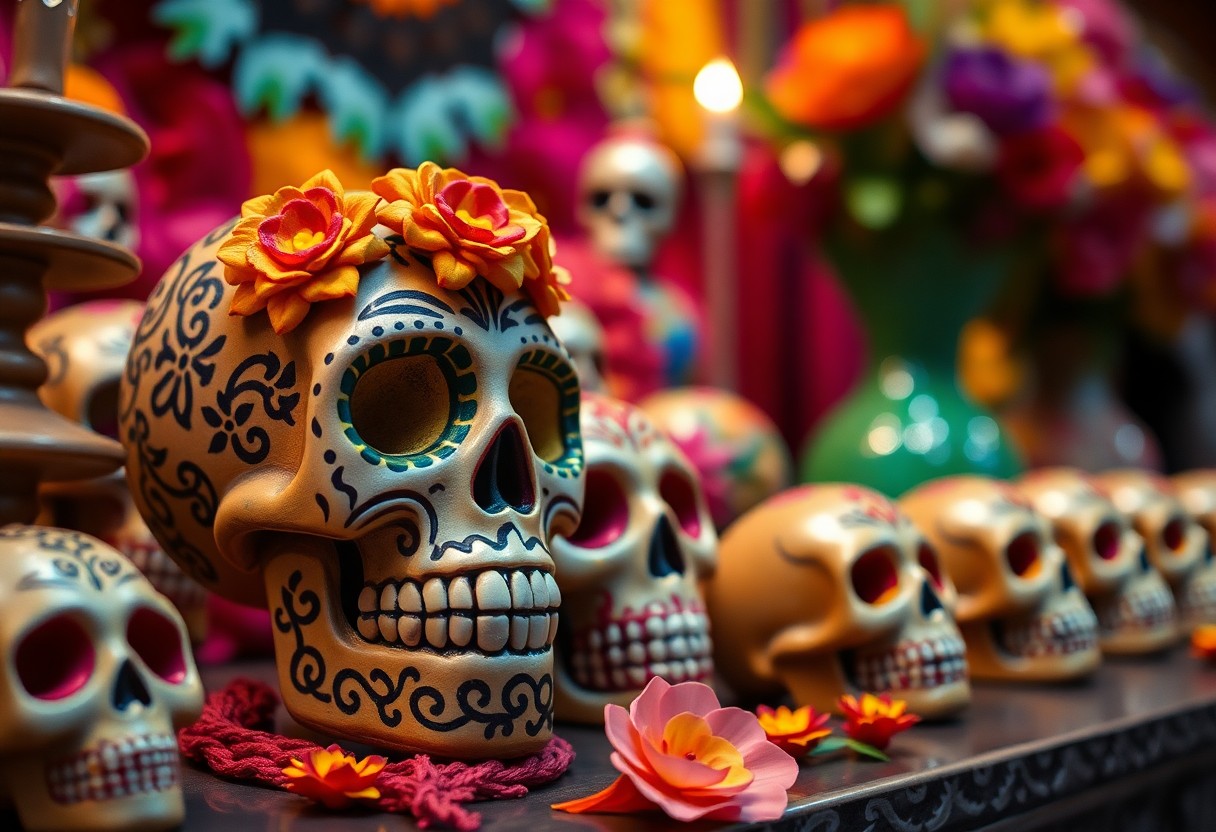
Types of Alfeñiques
Not all alfeñiques are the same. These sugar creations come in various forms, each with its own meaning and purpose. Here are the most common types:
- Skulls (calaveras): Representing deceased loved ones, often personalized with names.
- Animals: Symbolizing spiritual guides or pets of the departed.
- Crosses: Reflecting faith and the connection between life and death.
- Fruits: Signifying abundance and the sweetness of life.
- Angels: Representing protection and the spiritual realm.
Knowing the types of alfeñiques helps you appreciate their role in Día de Muertos celebrations.
| Type | Symbolism |
|---|---|
| Skulls | Deceased loved ones |
| Animals | Spiritual guides or pets |
| Crosses | Faith and life-death connection |
| Fruits | Abundance and sweetness of life |
| Angels | Protection and spirituality |
Traditional Designs
Traditional alfeñiques focus on classic symbols like skulls, crosses, and animals. These designs are deeply rooted in Mexican culture, often featuring bright colors and intricate details. You’ll notice they reflect the balance between life and death, a central theme of Día de Muertos. These timeless creations are still widely used in ofrendas today.
Modern Interpretations
Clearly, modern alfeñiques have evolved to include contemporary themes. Artisans now craft figures like superheroes, cartoon characters, and even celebrities. These designs appeal to younger generations while keeping the tradition alive. You’ll find these innovative pieces at fairs like the one in San Miguel de Allende, blending tradition with creativity.
For instance, modern alfeñiques often feature vibrant colors and unconventional shapes, making them stand out on altars. While some purists may view these changes as a departure from tradition, they help keep the art form relevant. The Alfeñique Fair in San Miguel de Allende showcases these modern designs, offering a glimpse into how this centuries-old craft continues to adapt.
Tips for Crafting Alfeñiques
All you need to craft alfeñiques is patience, creativity, and the right tools. Start by preparing your workspace with clean, flat surfaces. Use food-safe molds for consistent shapes and edible dyes for vibrant colors. Keep your sugar paste pliable by covering it with a damp cloth while working. Work in small sections to avoid drying out the paste. The key is to handle the sugar paste gently to prevent cracks. The final step is to let your creations dry completely before displaying them on your ofrenda.
Essential Ingredients and Tools
Crafting alfeñiques requires a few basic ingredients and tools. You’ll need granulated sugar, egg whites, and lemon juice to make the sugar paste. For shaping, use food-safe molds or sculpt by hand. Edible dyes or food coloring are necessary for adding vibrant hues. A rolling pin, small brushes, and a damp cloth are helpful for smoothing and detailing. With these items, you can create beautiful, traditional alfeñiques for your Día de Muertos altar.
Techniques for Beginners
Now that you have your ingredients and tools, start by kneading the sugar paste until it’s smooth and pliable. Roll it out evenly and press it into molds or shape it by hand. Use small brushes to add details with edible dyes. Work quickly to prevent the paste from drying out. If cracks appear, smooth them with a damp cloth or your fingers. The key is to practice and experiment with different shapes and colors to develop your skills.
To master alfeñique crafting, focus on precision and patience. Avoid overworking the sugar paste, as it can dry out and crack. Always keep your workspace clean to prevent contamination. Use food-safe materials to ensure your creations are safe to display and handle. The most important step is to let your alfeñiques dry completely before moving them, as they are fragile when wet. With practice, you’ll create stunning sugar art that honors the tradition of Día de Muertos in San Miguel de Allende.
Step-by-Step Guide to Making Alfeñiques
After gathering your ingredients and tools, follow this simple guide to create your own alfeñiques. The process involves preparing the sugar paste, shaping it into your desired forms, and decorating with vibrant colors. Below is a breakdown of the steps:
| 1. Prepare the Sugar Paste | Mix sugar, water, and lemon juice until smooth. |
| 2. Shape the Figures | Mold the paste into skulls, animals, or other symbolic shapes. |
| 3. Dry the Figures | Let the shapes air-dry for several hours until firm. |
| 4. Decorate | Use food coloring, icing, and edible glitter to add details. |
Preparing the Sugar Paste
You start by combining sugar, water, and lemon juice in a pot over medium heat. Stir continuously until the mixture reaches a thick, smooth consistency. Be cautious as the sugar can burn easily. Once ready, let it cool slightly before kneading it into a pliable dough. This paste forms the foundation of your alfeñiques, so ensure it’s smooth and free of lumps.
Shaping and Decorating
Preparing the figures is where your creativity shines. Roll the sugar paste into small balls or logs, then shape them into skulls, animals, or flowers. Use molds or your hands for precision. Once shaped, let the figures dry completely before adding color. Patience is key to avoid smudging the designs.
Sugar figures are delicate, so handle them with care during decoration. Use food-safe brushes to apply vibrant colors and edible glitter. Bright hues like red, yellow, and blue are traditional, but you can personalize your designs. Finally, let the decorations set before displaying your alfeñiques on your Día de Muertos altar.
Factors Influencing Alfeñique Artistry
For alfeñique artistry to thrive, several factors come into play. The skill of the artisan, the quality of ingredients, and the cultural significance of the craft all shape the final product. Key influences include:
- The artisan’s ability to balance tradition with creativity.
- The use of high-quality sugar paste and natural dyes.
- The preservation of techniques passed down through generations.
This combination ensures that alfeñiques remain a cherished part of Día de Muertos celebrations in San Miguel de Allende.
Cultural Traditions
Alfeñique artistry is deeply rooted in Mexican cultural traditions. You’ll find that these sugar figures are more than decorations; they are symbols of life, death, and remembrance. Crafted with care, alfeñiques reflect the spiritual connection between the living and the deceased. In San Miguel de Allende, artisans often incorporate local motifs and personal touches, making each piece unique. This tradition keeps the spirit of Día de Muertos alive, blending history with heartfelt creativity.
Regional Variations
Assuming you explore alfeñiques across Mexico, you’ll notice distinct regional variations. In San Miguel de Allende, artisans often create intricate skulls and colorful animals, while other regions might focus on crosses or flowers. These differences highlight the diversity of Mexican culture and the adaptability of alfeñique artistry. This regional flair adds depth to the tradition, making each piece a reflection of its origin.
Cultural influences shape the regional variations of alfeñiques. In San Miguel de Allende, the fusion of indigenous and Spanish traditions is evident in the designs. You’ll see vibrant colors and detailed patterns that reflect the town’s artistic heritage. However, in other regions, the use of natural dyes or simpler shapes might dominate. These variations not only showcase the creativity of artisans but also emphasize the importance of preserving local traditions. By appreciating these differences, you gain a deeper understanding of the cultural richness behind alfeñiques.
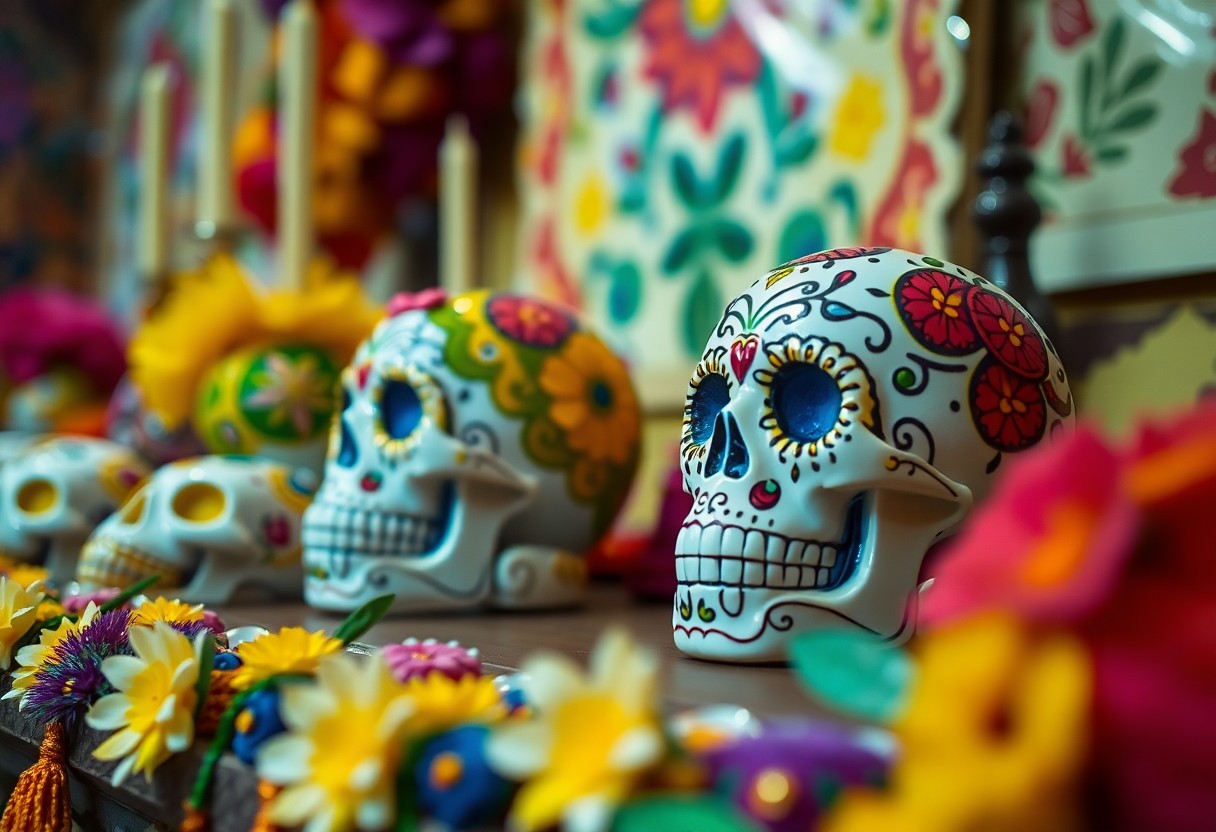
Pros and Cons of Alfeñiques
Now, let’s explore the advantages and disadvantages of alfeñiques, a cherished tradition in San Miguel de Allende. Below is a breakdown of their pros and cons:
| Pros | Cons |
| Symbolize cultural heritage | Fragile and easily breakable |
| Add vibrant beauty to ofrendas | Short shelf life due to sugar content |
| Handcrafted by skilled artisans | Labor-intensive to create |
| Celebrate life and death meaningfully | Susceptible to humidity and heat |
| Encourage local craftsmanship | Limited availability outside festivals |
Cultural and Artistic Value
You can see the cultural and artistic value of alfeñiques in their intricate designs and vibrant colors. These sugar figures are not just decorations; they are a testament to Mexico’s rich traditions and the skill of local artisans. Each piece tells a story, connecting you to the history and spirit of Día de Muertos. In San Miguel de Allende, the annual Alfeñique Fair highlights this artistry, showcasing how these creations honor both life and heritage.
Challenges in Preservation
Cultural preservation of alfeñiques faces significant challenges. The delicate nature of sugar art makes it prone to damage, and environmental factors like humidity can ruin these creations. Additionally, the labor-intensive process of making alfeñiques discourages younger generations from continuing the tradition, risking its future.
This issue is particularly pressing in San Miguel de Allende, where the tradition thrives but is threatened by modernization. The fragility of sugar art and the decline in artisan participation pose real dangers to its survival. However, efforts like the Alfeñique Fair help keep the tradition alive, offering hope for its continuation. By supporting local artisans and educating others, you can play a role in preserving this beautiful art form for future generations.
Final Words
With these considerations, you can see how the sweet art of alfeñiques enriches the Día de Muertos tradition in San Miguel de Allende. These sugar figures, crafted with care and creativity, symbolize the joy and reverence of honoring loved ones. By visiting the Alfeñique Fair, you immerse yourself in a vibrant celebration of culture and artistry. Alfeñiques remind you of the beauty in life and the importance of preserving traditions. Their presence on ofrendas connects you to the past while celebrating the present, making them a cherished part of Día de Muertos in San Miguel de Allende.
FAQ
What are alfeñiques, and why are they important during Día de Muertos?
Alfeñiques are handmade sugar paste figures shaped into skulls, animals, and other symbolic items. They are important during Día de Muertos because they decorate altars, or ofrendas, honoring deceased loved ones. These colorful figures symbolize the sweetness of life and the remembrance of those who have passed.
Where does the tradition of alfeñiques come from?
The tradition of alfeñiques comes from the Arabic word alfainid, introduced to Spain during the Moorish period. The Spanish brought this art form to the Americas, where it evolved in Mexico. Over time, Mexican artisans adapted the recipe and designs, creating the vibrant and intricate alfeñiques seen today.
What can visitors expect at the Alfeñique Fair in San Miguel de Allende?
Visitors to the Alfeñique Fair in San Miguel de Allende can see skilled artisans crafting traditional and modern sugar figures. The fair showcases a variety of designs, including skulls, crosses, animals, and flowers. It is a lively event that celebrates the art, tradition, and community spirit of Día de Muertos. The fair takes place at Plaza de la Soledad, near Oratorio Church.
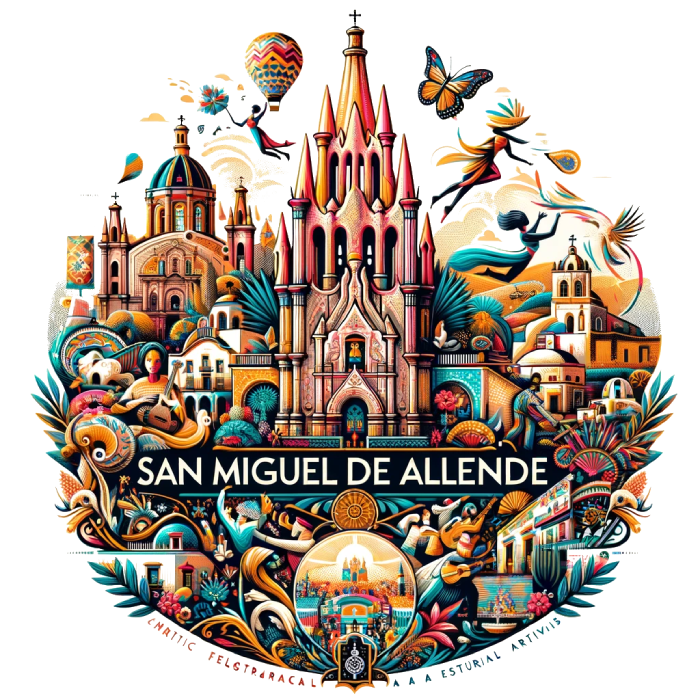


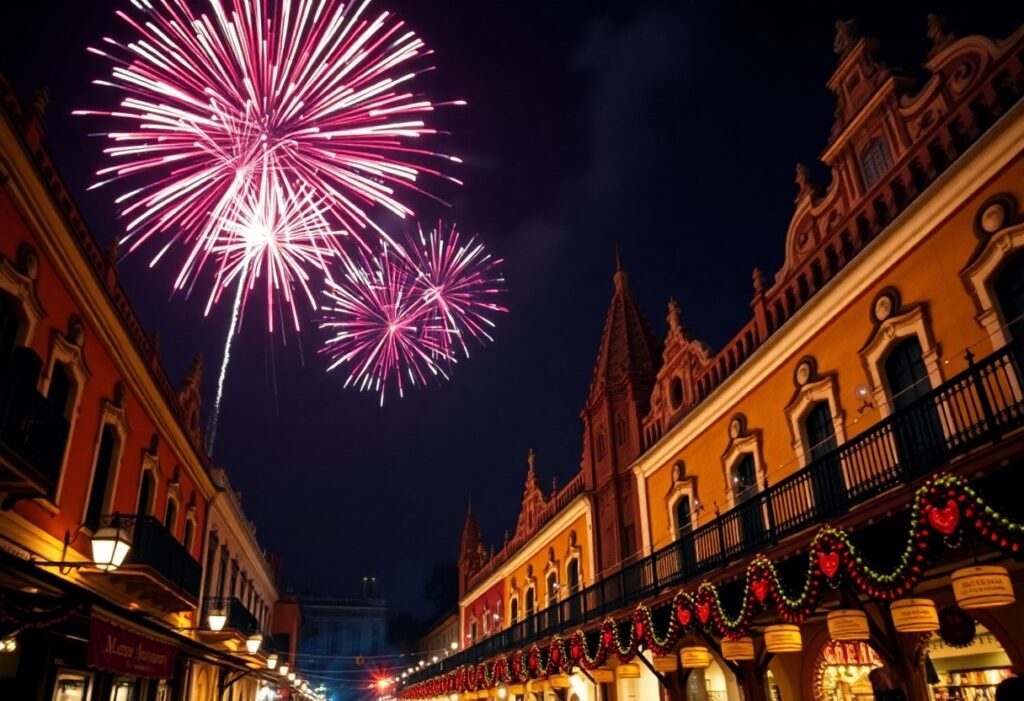
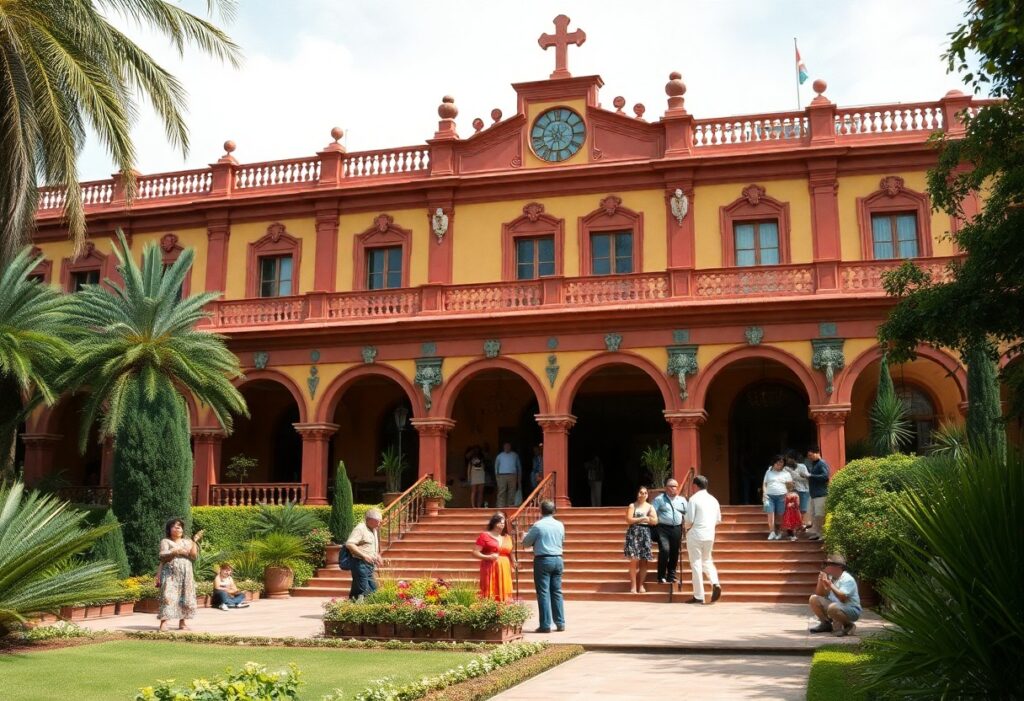
I’ve always found the artistry of alfeñiques fascinating, and your post beautifully captures their significance during Día de Muertos, especially in a place like San Miguel de Allende, which has such a rich cultural tapestry. The way these sugary creations serve not just as decorations, but as deep symbols of love and remembrance is something that really resonates with me.
It’s great to hear how much you appreciate the artistry of alfeñiques. There’s something truly unique about how they blend craftsmanship with cultural significance, especially in a place as vibrant as San Miguel de Allende. Each piece tells a story, often reflecting personal histories or family memories, which adds layers of depth to the celebration of Día de Muertos.
You’re spot on about the artistry of alfeñiques. It’s fascinating how these colorful, sugary creations are more than just eye candy—they carry family stories and cultural nuances that might get lost in translation elsewhere. Picture this: you’re wandering through San Miguel de Allende, and you come across a stall draped in a rainbow of these delicacies. Each piece, from the playful skulls to the intricate flowers, seems to whisper tales of those who came before us. It’s like a mini history lesson served on a fondant platter.
¡Así es! Si te interesa explorar más sobre la tradición de los alfeñiques y su impacto cultural, te invito a descubrir esta fascinante colección.
https://fallinginlovewithsanmiguel.com/tours-and-excursions
I totally get where you’re coming from. The artistry of alfeñiques really does have this unique charm, doesn’t it? It’s like each piece carries a story or a memory, making them so much more than just sugary creations. In San Miguel de Allende especially, you can feel the vibrancy of culture woven into every detail. The way they decorate altars during Día de Muertos adds this other layer to the celebration. It’s almost like a conversation across generations.
I love how alfeñiques beautifully bridge the gap between life and death, embodying both remembrance and celebration during Día de Muertos. Growing up in a multicultural environment, I’ve seen how traditions like these are crucial for keeping the memory of loved ones alive. The craftsmanship involved in creating these sugar figures truly reflects a deep respect for heritage.
It’s interesting how traditions like Día de Muertos resonate with people in such varied ways. Alfeñiques, with their intricate designs, really do serve as a touching reminder of our connections to those we’ve lost. It’s fascinating to see how they not only honor the memories of loved ones but also celebrate life in the process.
You raise such a poignant point about how Día de Muertos unfolds in various ways for different people. Alfeñiques really are a symbol of that intricate connection between life and death, don’t you think? They embody a kind of playfulness that contrasts with the often somber nature of loss, and I find that balance remarkably healing.
I completely resonate with what you’re saying about alfeñiques and their role during Día de Muertos. It’s fascinating how these sugar figures serve as more than just decorations; they really encapsulate the essence of honoring those we’ve lost. I remember the first time I participated in making them with my family. It was a blend of creativity and remembrance, casting a spotlight on our shared heritage.
It’s great to hear how deeply you connect with alfeñiques! They really do bring such a unique blend of artistry and tradition. The process of creating them, with family, turns into this beautiful act of storytelling and remembrance. Each figure often reflects memories or traits of the loved ones we’re honoring, making it a personal tribute. What was your favorite shape or character to make? It’s amazing how something so simple can spark conversations about the past and keep family stories alive.
I completely agree; the way alfeñiques embody both creativity and a deep sense of remembrance is truly special. It’s like each figure carries a little piece of our loved ones’ stories, making our altars come alive in a very tangible way. I remember the first time I joined in on making them as well. It was such a sensory experience—the bright colors, the sweetness of the sugar, and the laughter we shared while shaping the figures.
It’s really interesting to hear about your experiences with traditions like Día de Muertos, especially in a multicultural setting. Alfeñiques do have this amazing ability to walk that fine line between mourning and festivity. When you see those intricate designs and vibrant colors, it feels like they tell a story, doesn’t it?
You’re right about alfeñiques; they really do embody that blend of emotion and celebration. When I see their colorful shapes, I often think about how they serve as a medium for storytelling across generations. Each design feels deeply personal, capturing individual stories while also reflecting broader cultural narratives.
You’re spot on about alfeñiques. They really do embody that unique blend of mourning and celebration. Each design isn’t just pretty; they often reflect personal stories, memories, and emotions that add layers of meaning. For me, seeing those vibrant colors juxtaposed against the somber nature of the day opens up a fascinating conversation about life and loss.
The intricate world of alfeñiques truly captures the essence of Día de Muertos and highlights how food can serve as a bridge between the living and the departed. I believe these delicate sugar figures not only honor our loved ones but also reflect the rich tapestry of cultural influences that shape Mexican traditions. It’s fascinating to think about how the merger of Arabic, Spanish, and indigenous elements over centuries has created such a unique art form.
The connection you highlight between alfeñiques and the broader tapestry of Día de Muertos is spot on. It’s interesting to consider how these sugar figures are more than just decorations—they’re symbols woven into the very fabric of our cultural heritage. Each alfeñique, whether shaped as a skeleton or adorned with colorful patterns, carries the weight of history.
Your exploration of alfeñiques highlights a fascinating intersection of art and cultural memory. The delicate nature of these sugar figures not only reflects the skill of the artisans but also serves as a poignant reminder of our connection to those we’ve lost. I’m curious about how modern interpretations of alfeñiques are evolving. In a world increasingly driven by technology, do you think there’s a risk that traditional crafts like this might be overshadowed or lose their authenticity? It would be interesting to hear thoughts on how artisans balance preserving heritage while appealing to contemporary tastes. Additionally, the shift in how we connect with death in today’s society could impact the way these symbols are perceived—what do you think?
Your observations about alfeñiques really resonate with me. It’s true that these exquisite sugar figures do embody both the craftsmanship of the artisans and our collective experience of loss and remembrance. I often think about how these traditions become the threads that weave our cultural narratives together.
It’s so interesting how alfeñiques really do serve as a bridge between artistry and memory. When you see those sugar figures, it’s like each one tells a story, connecting us not just to our own experiences but to a whole history of celebration and mourning. I often find myself reflecting on how these traditions evolve over time, adapting yet staying rooted in their original meanings. It’s fascinating to consider how each artisan brings their own flair to the craftsmanship, making each piece unique while still fitting into that larger narrative. What’s your favorite memory tied to these celebrations?
I appreciate your reflections on alfeñiques. It’s fascinating how these sugar creations serve as more than just sweets. They are infused with history and emotion, connecting us both to our ancestors and to each other. Each figure represents a moment in time, a personal story wrapped in the art of craftsmanship. The artisans who make them, often learning from generations before, truly create a bridge between past and present.
Your observations about alfeñiques really hit the mark. The way these sugar figures bridge artistry and memory is both enchanting and thought-provoking. They encapsulate not just artistic skill but also the stories and connections we maintain with those who have passed on.
I appreciate your take on alfeñiques; it really captures their essence. It’s fascinating how these sugar figures encapsulate not just artistic skill but also rich narratives tied closely to memory and emotion. In many ways, they remind me of other cultural practices that blend art and remembrance, like the way certain food traditions are passed down through generations.
You’ve touched on something quite profound about alfeñiques and their connection to memory and emotion. It’s intriguing to think about how these delightful sugar figures serve as more than just decorative pieces; they are storytellers of our personal and communal histories. Each vibrant piece encapsulates memories tied to celebrations and traditions, often linked to times in our lives filled with joy or reverence, such as Día de Muertos.
You’ve really captured the essence of alfeñiques and their deeper significance. It’s fascinating how something that appears so simple—a decorative sugar figure—can hold such complex ties to our emotions and experiences. I remember the first time I participated in Día de Muertos, how overwhelmed I felt by the energy in the air and the stories shared through these little figures. Each one seemed to come alive with its unique history, connecting generations in a way that transcends mere celebration.
It’s true that alfeñiques have such a unique way of blending artistry and emotion, almost like they carry whispers of the past within their sugary forms. I think it’s really intriguing how these traditions evolve, much like food culture does. For instance, I’ve noticed that family recipes often hold stories of resilience, love, and history – like how my grandmother would always say certain dishes were a way to honor our ancestors during family gatherings.
You’ve touched on something beautiful here. The connection between alfeñiques and family traditions really highlights how food and artistry are woven into the fabric of our lives. It’s fascinating to think about how every piece of candy represents not just a moment in time but also the emotions and stories passed from one generation to the next.
I truly appreciate your exploration of alfeñiques and their significance in Día de Muertos celebrations. The blend of cultural influences in their creation really speaks to the rich tapestry of Mexican history. I remember visiting the Alfeñique Fair in San Miguel de Allende a few years ago, and it was fascinating to see artisans skillfully shaping sugar into intricate designs. Each piece felt like a story of its own, capturing a unique aspect of the culture.
Your description of alfeñiques beautifully captures their significance during Día de Muertos. I find it fascinating how these sugar figures serve as a bridge connecting us to our ancestors, transforming the experience of loss into a celebration of life and memory. In my own family, we include alfeñiques on our altar to honor loved ones who have passed, and it always sparks conversations about their lives. It’s intriguing how these traditions, deeply rooted in our cultural heritage, remind us of the intricate tapestry of influences that shape our customs. I also appreciate the mention of the Alfeñique Fair; it must be a stunning opportunity to see the craftsmanship firsthand. Have you had a chance to attend? I’d love to hear more about your experiences or thoughts on how these traditions could evolve in contemporary celebrations.
I completely resonate with your reflections on alfeñiques and their role during Día de Muertos. They really do encapsulate the duality of grief and celebration, don’t they? I love hearing how your family incorporates them to spark conversations about your ancestors. It’s such a beautiful way to keep their memories alive while creating opportunities to share stories that are often passed down through generations.
It’s really heartening to see how the tradition of alfeñiques resonates so personally for you and your family. They are such a powerful way to keep our loved ones’ memories alive and make the Día de Muertos celebrations feel tangible and intimate. When we place those sugar figures on the altar, it’s like we’re inviting our ancestors back into the fold, transforming our sorrow into an opportunity to reminisce, share stories, and keep their spirit vibrant in our lives.
Your reflections on alfeñiques resonate deeply. It’s remarkable how these delicate sugar figures embody both memory and celebration, allowing us to honor those we’ve lost while sharing their stories. When we place alfeñiques on our altars, they spark conversations that keep memories alive, connecting generations in a beautiful way.
You highlight such an important aspect of alfeñiques—the way they become storytellers themselves. Each piece carries a history, and the act of placing them on altars turns into a ritual of remembrance and connection. It’s fascinating how these small figures can provoke such rich discussions among family members, bridging gaps between different generations.
The tradition of crafting alfeñiques beautifully illustrates how art can serve as a bridge between life and the memories of those we’ve lost. Living in a culture where death is often viewed with fear or avoidance, the vibrant celebration of Día de Muertos, coupled with the artistry of alfeñiques, challenges this perception by transforming grief into a celebratory remembrance.
You’ve really captured the essence of what Día de Muertos and alfeñiques bring to the table. It’s fascinating how this tradition flips the script on our typical views of death, right? Instead of a gloomy farewell, it’s about celebrating lives lived and remembering those special moments.
You raise an interesting point about how alfeñiques function as a means of navigating the complexities of grief. It’s true that in many parts of the world, death is often shrouded in sadness or fear, whereas in cultures that embrace Día de Muertos, death is woven into the fabric of life in a way that feels more integrated and respectful.
You’ve touched on an important aspect of how different cultures relate to death. In communities that celebrate Día de Muertos, like those in Mexico, there’s a remarkable ability to face the inevitable with an open heart. The alfeñiques, these colorful sugar offerings, represent not just a recognition of mortality but a way to celebrate the lives lived.
It’s such an insightful observation. The way alfeñiques are crafted really does reflect a deep connection to memory and love. In many cultures, the conversation around death can feel heavy, often shrouded in fear or discomfort. But with Día de Muertos, there’s a unique shift—what traditionally brings sorrow is transformed into an opportunity to celebrate and honor those who have passed.
You make such a great point about the cultural shift surrounding Día de Muertos. It’s interesting how different communities have this ability to reshape narratives around death. Instead of being something we dread, it becomes a canvas for connection and reflection.
“Estoy encantado de que compartas esa perspectiva. Si te interesa profundizar en esta celebración, te invito a descubrir más sobre la riqueza de las tradiciones de Día de Muertos aquí.”
https://fallinginlovewithsanmiguel.com/transport
The artistry of alfeñiques truly reflects the heart of Día de Muertos, merging beauty and tradition in such a profound way. It’s fascinating to think about how these sugar figures not only celebrate loved ones but also serve as a reminder of our own connections to heritage and culture. I remember visiting a local Día de Muertos altar where alfeñiques were prominently displayed; the vibrant colors and intricate details seemed to breathe life into memories. It made me realize how art can play a vital role in processing grief and celebrating life.
The intricate artistry of alfeñiques truly illustrates the deep connection between culture and remembrance in Día de Muertos. However, I wonder about the sustainability of these sugary creations. While they are beautiful and steeped in tradition, there’s also a growing conversation around the environmental impact of sugar production.
You bring up an important point about the sustainability of alfeñiques and the broader implications of sugar production. It’s true that while these creations capture the vibrant spirit of Día de Muertos, we shouldn’t ignore the environmental issues linked to sugar farming, from deforestation to water use.
You raise an important point about the sustainability of alfeñiques and the broader issues tied to sugar production. It’s true that while these decorative sugar figures play a vital role in the Día de Muertos tradition, we must also confront the environmental consequences of sugar cultivation, which can include deforestation, pesticide use, and significant water consumption.
The points you’ve raised are spot on and resonate deeply with anyone who pauses to think about the traditions we hold dear. Alfeñiques, with their vibrant colors and unique shapes, symbolize so much more than just sugar—they represent family connections, memories, and a cultural heritage that is rich and complex. However, the shadow of sugar production looms larger every year as we grapple with its environmental impact.
I love how you captured the essence of alfeñiques and their role in Día de Muertos. It’s fascinating to think about not just their beauty, but the stories and memories they represent. The way they connect different cultural influences—Arabic, Spanish, and Mexican—is a testament to how rich and layered our traditions can be.